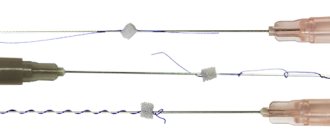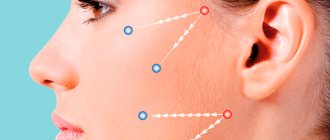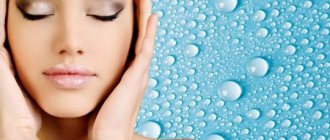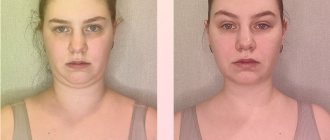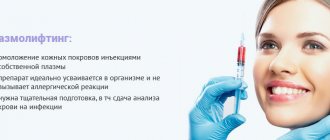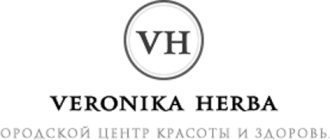What to do when you feel that the usual procedures of a cosmetologist are no longer enough? The reflection in the mirror is not pleasing, but is it both too early and scary to see a plastic surgeon? Many people are starting to think about thread lifting.
Preserve youth, correct the swollen oval of the face, raise the eyebrows - these and other shortcomings can be corrected by thread lifting. And it will delay visiting a plastic surgeon for several years.
A thread lift is a minimally invasive method of correcting age-related changes using special threads that fix the soft tissues of the face in a “young” position.
Types of threads for lifting
All threads are divided into absorbable and non-absorbable.
The threads also differ in their tasks:
- There are threads whose task is to tighten and strengthen the skin. They are called reinforcing. They come in different thicknesses, smooth and spiral.
- Threads that are designed to lift sagging tissue and smooth out age wrinkles.
Aesthetic surgeon Oleg Soldatov specializes in absorbable threads.
Advantages of absorbable threads:
- dissolve 12 months after administration, but leave a long-term effect for about 1-2 years
- do not form scar tissue, but stimulate the production of “correct” collagen
- thanks to the variety of types and forms, it is possible to target and effectively combat ptosis of certain areas of the face and body
- absorbable threads do not subsequently interfere with plastic surgery
- As a rule, they do not cause allergies.
- They do not interfere with future plastic surgeries, as non-absorbable threads remain under the skin forever and subsequently interfere with plastic surgery.
The essence of absorbable lifting threads
The lifting technique involves inserting fixing threads under the patient’s skin through micro-punctures. The threads dissolve after 1 year, releasing polylactic acid, which stimulates collagen production. Figuratively speaking, a natural framework is formed under the skin, which keeps the tissue in a taut state.
Of course, thread lifting cannot be compared with plastic surgery. During plastic surgery, the skin is excised; in the case of threads, these are small punctures and the ability to support the tissue and prevent its premature sagging. Thus, thread lifting is an opportunity to prolong your youth.
When is a facelift done?
With ptosis of the oval face, when there is drooping of the soft tissues, the chin angles become less pronounced, and the skin loses its tone, the choice is no longer so great. A facelift is the only way to restore contours. Thread lifting involves the introduction under the skin using a flexible cannula needle of the thinnest absorbable or non-absorbable threads, followed by tension and fixation of soft tissues. Facelift (SMAS) is a serious plastic surgery during which the surgeon works not only with the epidermis, but also with the deeper subcutaneous muscular-fibrous layer. Lifting the oval of the face is carried out by detaching and moving deeper layers, resection of excess stretched skin that forms folds, with their subsequent fixation using sutures hidden in the natural folds of the skin in the area of the ears. Facelift requires preparation, the rehabilitation period takes longer, but the effect is worth it! The range of indications for facial plastic surgery is more limited than for mesothreads.
General indications for facelift with mesothreads and surgery (SMAS)
- Ptosis of the oval face and skin (“triangle of youth” is turned upside down);
- Nasolabial folds;
- Wrinkles on the forehead and around the lips,
- Expression wrinkles around the eyes;
- Age-related drooping of the corners of the lips and eyes;
- The face looks tired and permanently swollen;
- Unclear mental angles;
- Asymmetry.
To one degree or another, both methods help to cope with these shortcomings. However, if a facelift allows you to visually look younger by 10-15 years, then a less radical thread lifting can make you look 5-7 years younger. After 50 years, if there are deep wrinkles, jowls, nasolabial folds, or significant sagging of the face, the wisest decision would be to undergo a SMAS facelift. After 40 years, a facelift with mesothreads or endoscopy of individual areas is usually sufficient.
Recommendations after the procedure
Although the facial lasts less than an hour, swelling will persist for the first two weeks. To make the rehabilitation period go smoothly, you need to follow several points:
- avoid active facial expressions for several days;
- do not wear makeup for at least 12 hours
- Microcurrent therapy and Zerona are recommended.
- avoid physical activity for 14 days
- give up alcohol for 5 days
- do not visit solariums, baths, saunas for up to 14 days, swimming pools for up to 2 months
- myostimulation procedures are contraindicated for 2 months.
SMAS facelift: pros and cons
Pros of facelift
- The rejuvenation is so pronounced that after the operation they don’t believe your passport age;
- Long-term effect;
- You do not experience pain during the operation. Even after the intervention, they are not very pronounced - the face does not hurt, and discomfort can be reduced with the help of ultraphonophoresis and painkillers;
- You can reduce swelling after a facelift and shorten rehabilitation using a lymphatic drainage massage procedure;
- The effect will be pronounced even in patients with full faces;
- In one operation you can cope with all aesthetic imperfections.
Cons of facelift
- There are strict contraindications (including anesthetic ones);
- Need preparation;
- Not the easiest and fastest rehabilitation;
- Risks of surgery (damage to the facial nerve);
- The price of the operation is higher than that of the procedure with mesothreads.
How does thread lifting of the forehead and eyebrows work?
If there is active facial expression between the eyebrows or the area around the eyes, it is recommended to perform botulinum therapy to eliminate active facial expressions and securely fix the tissues in the desired position.
Stages of implementation
The RESORBLIFT® thread lifting procedure is prescribed by a doctor after an examination, a thorough history taking, and, if necessary, some laboratory tests.
On the day of the procedure, a photo of the patient is taken in 5 standard projections, and markings are made for each specific patient, taking into account his individual characteristics. Under local anesthesia and pre-treatment of the thread implantation site, the threads are directly installed according to individual markings through small punctures with good fixation and tissue tension. Next, postoperative treatment of the area where the threads are installed and, if necessary, fixation with a bandage mask or strips.
Rehabilitation
The recovery period after thread implantation in the forehead area is reduced to zero, even small bruises are absent, this is due to the anatomical features of this area and the technique of installing threads.
Pros and cons
It is recommended to resort to lifting with threads in the following cases:
- the presence of wrinkles between the eyebrows and on the forehead (degrees 2–3);
- asymmetry of eyebrows, their drooping;
- drooping corners of the eyes;
- drooping upper eyelid.
A thread lift is suitable for those patients who first turned to a cosmetologist with minor age-related skin changes, as well as for those who have repeatedly resorted to aesthetic procedures.
Contraindications to the procedure due to the introduction of biostimulating materials:
- bleeding disorder, hemophilia;
- oncological diseases;
- skin diseases;
- mental disorders;
- problems with the heart, blood vessels, endocrine system;
- diabetes;
- autoimmune and somatic diseases.
Thread lifting of eyebrows and forehead is not recommended for pregnant and breastfeeding mothers.
Relative contraindications
for the procedure: persons taking blood thinning medications, as well as during exacerbation of chronic diseases.
Those who have a predisposition to hypertrophic and keloid scarring should be careful. They are at risk of developing skin defects.
PREPARATION, REHABILITATION PERIOD AND CONTRAINDICATIONS
- A few days before the procedure, you should not drink alcohol or take medications that thin your blood.
On the eve of the procedure, active physical activity, sauna and steam bath, and visiting the solarium are contraindicated. The rehabilitation period after eyebrow lifting with threads is up to 10 days. In the first 1-2 days, slight swelling may persist. A specialist gives detailed recommendations about the recovery period after the procedure, but in general the restrictions are the same as before the procedure, plus physical activity, sleeping on the stomach, and intense facial expressions are undesirable. Thread lifting is contraindicated in inflammatory processes, acute respiratory viral infections, blood diseases with coagulation disorders, pregnancy, lactation and a number of other conditions, which the doctor will warn you about during an in-person consultation.
Recovery period
For several days after the insertion of the threads, minor hematomas and swelling may persist on the skin in the upper part of the face, and tingling may be felt. When such symptoms disappear, this will indicate healing.
It should be understood that connective tissue – a collagen framework – takes 56 days to form, but the primary lifting result will be noticeable within three weeks. Over the course of six months it will increase and will persist for a year to two or more years.
In the first three days after the procedure, you should not touch your face with your hands or use cream or powder.
It is very important to properly maintain facial hygiene during the healing period. You can’t get this place wet, but you can use antiseptic solutions - 0.05% chlorhexidine digluconate solution). They need to wipe the skin 2 times a day.
In addition, the following recommendations must be followed:
- limit active facial expressions;
- sleep on your back;
- Apply an elastic bandage at night;
- avoid hot food and drinks for 3-5 days after the procedure;
- do not stay in the sun for a month after the procedure;
- do not visit the dentist for 1 month;
- do not exercise for 2 - 3 weeks;
- refuse the pool, sauna, bathhouse, beach;
- refrain from drinking alcohol and smoking for 14 days after thread lifting;
- Do not massage for 1 month after the procedure.
You just need to be patient for a little while, but a fresh look, a smooth forehead, beautifully defined eyebrows, and an open look will be your reward for a long time!
Stages of the procedure
Thread lifting, like any lift, requires certain preparation. The cosmetologist begins with a consultation: he talks in detail about the technique, the material used and provides certificates for it, how many threads are needed.
The specialist examines the client’s medical history, asks him about existing diseases, the presence of allergic reactions, whether he has had operations, what cosmetic procedures he has undergone. In some cases, it may be necessary to undergo additional tests - this is necessary to prevent undesirable consequences and predict the timing of rehabilitation.
After studying the condition of the area where the threads will be implanted, their type, quantity and injection scheme are determined individually.
The main stage of thread implantation
First of all, the doctor takes pictures of the patient in five projections for subsequent comparison with the results of using thread technology. Next step by step:
1. The patient’s hair is tucked under a cap, and the skin is cleaned of cosmetics and other contaminants. Next, thoroughly treat with an antiseptic solution (betadine, chlorhesidine, etc.) to disinfect the skin.
2. Now it comes to anesthesia. Lidocaine cream or ultracaine solution is used for long-term anesthesia.
3. The doctor marks with a marker the points where the threads will be inserted.
4. The package with threads is opened. This is done in front of the patient.
5. The thread is implanted using a microscopic needle puncture - it is inserted under the skin to a depth of 2 - 3 mm and removed through another puncture.
6. To fix the fabric with notches, the thread is pulled.
7. The needles are removed from the skin, the puncture sites are inspected, and cooling packs are applied to them.
8. After some time, the skin is once again treated with antiseptics.
How is thread lifting performed using surgical threads?
At the first stage, markings are applied to the patient’s face, defining the “route” for introducing the threads. The skin is treated with an antiseptic and “pricked” with a local anesthetic. At the next stage, through punctures/incisions (depending on the type of thread), cannulas with threads are inserted under the skin and, through small incisions, attached to bone structures in invisible places - at the level of the scalp/temporal fascia. As a rule, for lifting the lower part of the face, incisions are made behind the ears, for the upper part - in the temple area. The surgeon then closes the incision in layers.
Contraindications to thread lifting with surgical threads
- pregnancy and lactation;
- allergic reactions to anesthetics;
- neoplasms, inflammation in the correction zone;
- poor blood clotting;
- infectious and chronic diseases in the acute phase;
- neurological diseases;
- oncology;
- tendency to form keloid scars.
If there is a significant excess of skin tissue and severe ptosis in the correction area, implantation of surgical threads is an ineffective method of tightening. Also, the procedure is not indicated in cases where, in addition to ptosis, there is excess subcutaneous fat - preliminary liposuction is recommended.
Advantages of the technique
During a facelift with threads, there is no surgical intervention, so no scars, scars or other defects remain on the body. The recovery period after the procedure is short.
The technology allows us to solve the following problems:
- initial signs of aging;
- wrinkles;
- drooping eyebrows, cheeks, lower and middle facial zones;
- pronounced folds (nasolabial, nasolacrimal, labiomental).
A facelift with threads differs from most anti-aging techniques in the following advantages:
- safety;
- simplicity of the procedure;
- minimally invasive;
- efficiency (results are noticeable immediately);
- predictability.
The essence of the procedure, its advantages and contraindications
This method of face lift involves reinforcing the skin with threads in certain directions to form an invisible frame. Mesothreads, when absorbed, strengthen the connective fibers of the skin with new collagen tissue, which leads to strengthening of the oval of the face. The number and arrangement of threads allows you to completely model the contour of the face or tighten the skin only in the desired areas.
The main advantages of thread lifting - instant results and the half-hour duration of the procedure do not exhaust all the advantages of the technique. In the reviews, patients also note:
- Safety of implanting threads into the skin through miniature punctures.
- No discomfort, traces (bruises, swelling, scars) and complications.
- The thinnest mesothreads are invisible in appearance and to the touch, which dissolve on their own without requiring removal.
- Elimination of injury, minimizing the rehabilitation period.
- No incisions and quick healing of punctures.
The skin tightening effect appears immediately after the procedure. During the process of resorption of the facelift threads, a frame is formed that enhances the initial effect. Compliance with a certain architecture allows you to model a reinforcing contour of the desired shape, which harmoniously connects with the natural oval of the face. The result obtained lasts up to 5 years.
There are very few contraindications for thread lifting, in contrast to surgical lifting methods.
PRICE OF EYEBROW LIFTING WITH THREADS IN St. Petersburg
The cost of this procedure depends on the degree of complexity (the number and length of threads required), the materials chosen and the skill level of the specialist who will perform the lift. At the GMTClinic center you can choose the optimal rejuvenation option at patient-friendly prices. In consultation with a Center specialist, you can get answers to all your questions and choose a suitable rejuvenation program, which includes only effective and safe methods.
By calling the phone numbers listed on the website, you can make an appointment and choose a convenient time for consultation. You can also use the feedback form or online consultant to do so right now.
If eyebrow lifting is done with threads, then at GMTClinic!

